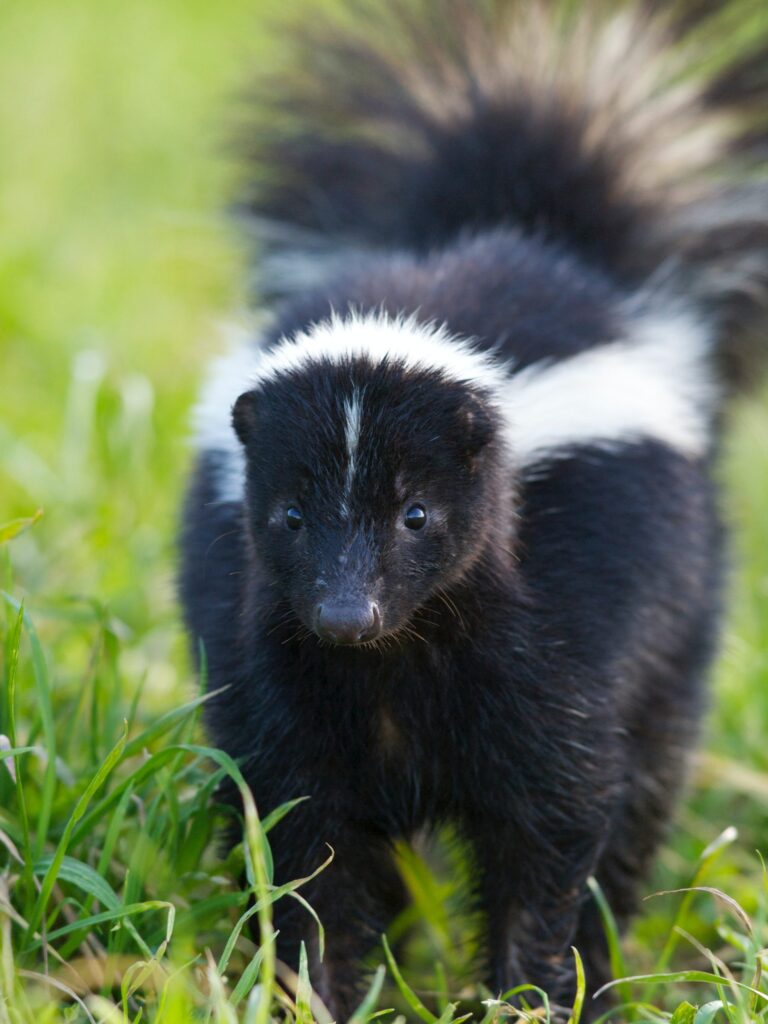The Striped Skunk (Mephitis mephitis) is a small, nocturnal mammal known for its distinctive black and white coloration and its infamous defense mechanism: a powerful and pungent spray. Visit our North American Natives exhibit to observe these intriguing creatures up close. Let’s explore their diet, habitat, size, and conservation status, as well as some fascinating facts that make the Striped Skunk a truly unique species.

Diet
Striped Skunks are omnivorous, with a diet consisting of a wide variety of foods. They primarily feed on insects, grubs, and other invertebrates, but also consume small mammals, birds, eggs, and amphibians. Additionally, they eat fruits, berries, nuts, and other plant materials, depending on the season and availability. Their diverse diet allows them to adapt to a range of environments.
Habitat
Striped Skunks inhabit a variety of environments across North America, from southern Canada to northern Mexico. They can be found in grasslands, forests, agricultural areas, and even urban settings. Striped Skunks prefer habitats with ample shelter, such as hollow logs, rock piles, and abandoned burrows, where they can hide from predators and rear their young.
Size and Weight
Striped Skunks are small, stocky mammals, with a body length typically ranging from 22 to 30 inches (56 to 76 cm), including their bushy tail. They generally weigh between 4 to 10 pounds (1.8 to 4.5 kg), with males being larger and heavier than females.
Striped Skunk Skull
The skull of the Striped Skunk is distinctive, featuring a small, conical shape with robust teeth adapted for an omnivorous diet. The dental formula is made of 1 molar on each side of the upper jaw and 2 molars on each side of the lower jaw, resulting in a 3.1.3.1/3.1.3.2 arrangement, totaling 34 teeth. Their elongated rostrum and well-developed auditory bullae enhance their sense of smell and hearing, compensating for their relatively poor vision.
Conservation Status
The Striped Skunk is currently listed as “Least Concern” on the International Union for Conservation of Nature (IUCN) Red List. Their population is considered stable across most of their range, although they may face local threats such as habitat loss, vehicle collisions, and persecution due to their reputation for carrying rabies and producing foul odors.
Fascinating Facts
Powerful Defense Mechanism:
Striped Skunks are famous for their ability to spray a foul-smelling liquid from their anal glands when threatened. This pungent spray can reach up to 10 feet (3 meters) and temporarily blind or disorient predators, allowing the skunk to escape.
Warning Coloration:
The Striped Skunk's distinctive black and white coloration serves as a warning to predators. The bold pattern signals to potential threats that the skunk is equipped with a powerful defense mechanism, often deterring attacks.
Solitary Creatures:
Striped Skunks are primarily solitary animals, except during the mating season or when a female is raising her young. They are nocturnal, foraging for food under the cover of darkness and seeking shelter in dens during the day.
Delayed Implantation:
Striped Skunks have a unique reproductive strategy called delayed implantation. After mating, the fertilized egg does not immediately implant in the uterus. Instead, it remains dormant for several weeks before implanting and beginning to develop, allowing the young to be born at an optimal time when food is more abundant.
Natural Pest Control:
Striped Skunks play an essential role in controlling insect and rodent populations. By feeding on agricultural pests such as grubs, beetles, and mice, they help to maintain a balanced ecosystem and reduce the need for chemical pest control.
Visit the Striped Skunk at the Abilene Zoo
During your visit to the Abilene Zoo, be sure to stop by our Elm Creek exhibit to observe the captivating Striped Skunk.
FAQ
Can striped skunks climb?
Striped skunks aren’t great climbers as their long nails make climbing tricky. They can manage to climb up fences and boards, but you’ll rarely see them in trees. Using their strong hind legs, they can jump about three feet, which helps them move from one resting spot to another.
Are striped skunks endangered?
Due to their wide distribution in North America, from southern Canada to northern Mexico, the striped skunk is classified as least concern on the IUCN Red List. They adapt to diverse habitats such as city centers, suburban communities, and countryside regions.